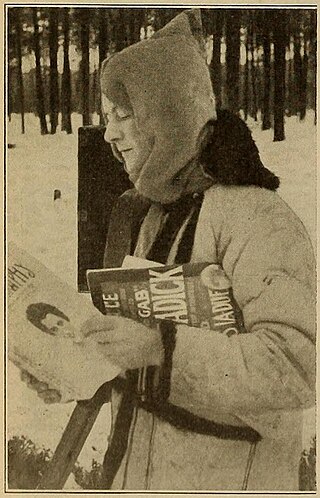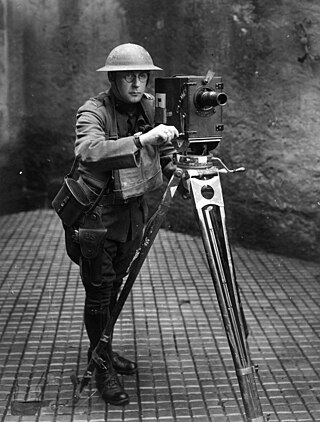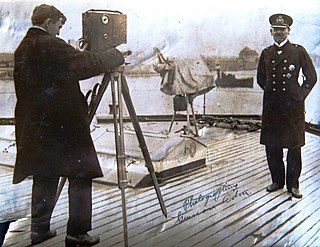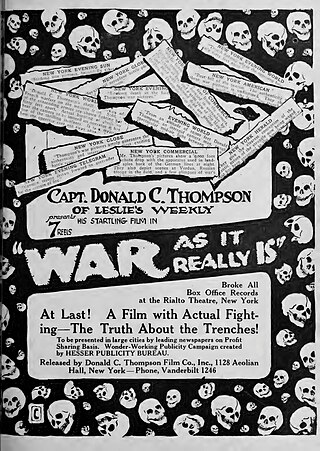Related Research Articles

The Western Front was one of the main theatres of war during the First World War. Following the outbreak of war in August 1914, the Imperial German Army opened the Western Front by invading Luxembourg and Belgium, then gaining military control of important industrial regions in France. The German advance was halted with the Battle of the Marne. Following the Race to the Sea, both sides dug in along a meandering line of fortified trenches, stretching from the North Sea to the Swiss frontier with France, the position of which changed little except during early 1917 and again in 1918.

The Christmas truce was a series of widespread unofficial ceasefires along the Western Front of the First World War around Christmas 1914.

World War I was the first major conflict involving the use of aircraft. Tethered observation balloons had already been employed in several wars and would be used extensively for artillery spotting. Germany employed Zeppelins for reconnaissance over the North Sea and Baltic and also for strategic bombing raids over Britain and the Eastern Front.

The United Kingdom was a leading Allied Power during the First World War of 1914–1918. They fought against the Central Powers, mainly Germany. The armed forces were greatly expanded and reorganised—the war marked the founding of the Royal Air Force. The highly controversial introduction, in January 1916, of conscription for the first time in British history followed the raising of one of the largest all-volunteer armies in history, known as Kitchener's Army, of more than 2,000,000 men. The outbreak of war was a socially unifying event. Enthusiasm was widespread in 1914, and was similar to that across Europe.
During World War I, the German Empire was one of the Central Powers. It began participation in the conflict after the declaration of war against Serbia by its ally, Austria-Hungary. German forces fought the Allies on both the eastern and western fronts, although German territory itself remained relatively safe from widespread invasion for most of the war, except for a brief period in 1914 when East Prussia was invaded. A tight blockade imposed by the Royal Navy caused severe food shortages in the cities, especially in the winter of 1916–17, known as the Turnip Winter. At the end of the war, Germany's defeat and widespread popular discontent triggered the German Revolution of 1918–1919 which overthrew the monarchy and established the Weimar Republic.

During World War I, the United States saw a systematic mobilization of the country's entire population and economy to produce the soldiers, food supplies, ammunitions and money necessary to win the war. Although the United States entered the war in April 1917, there had been very little planning, or even recognition of the problems that Great Britain and the other Allies had to solve on their own home fronts. As a result, the level of confusion was high in the first 12 months.

Albert Knox Dawson was an American photojournalist and film correspondent who covered World War I with the German, Austro-Hungarian and Bulgarian Armies.

Edwin Frederick Weigle was a cameraman for the Chicago Tribune, cinematographer and documentary film maker.

Hans Theyer (1884–1955) was an Austrian cinematographer. From 1907, Theyer travelled around the world as a newsreel cameraman for Pathé. Theyer’s work took him as far as China, Alaska, the South Sea Islands, Africa and the Middle East. In January 1914, Theyer was employed as a cinematographer for the German Messter film studio. At the outbreak of World War I he was assigned by Messter to the German War Office to produce films on the German war effort. In January 1915, Theyer was sent to the Western Front and to occupied Belgium to record a film together with American film correspondent Albert K. Dawson.
Roger A. Graham was an American lyricist, composer, singer, and music publisher who flourished from 1906 to 1920 — a period that included World War I, the golden age of Tin Pan Alley, the dawn of the Jazz Age (circa 1914), and the silent film era. Graham was a proponent of vaudeville and burlesque songs. But as a lyricist and publisher, Graham is most remembered for having been an exponent of blues songs.

Donald C. Thompson (1885–1947) was an American war photographer, cinematographer, producer and director known primarily for his still and motion picture work during World War I. Thompson repeatedly risked his life to capture the war on film, and then would return to the United States to share his experiences and images in public lectures, bringing the horrors of the war to US audiences. His work was widely shown in the US prompting one magazine to note that "nearly every reader of news of the great European war is familiar with the name of Donald C. Thompson, known the world over as ‘The War Photographer from Kansas.’” War correspondent E. Alexander Powell said that Thompson had “more chilled-steel nerve than any man I know.”

Wilbur Henry Durborough was a photojournalist and film correspondent who covered World War I with the German army.

Ansel Earle Wallace was a photojournalist and newsreel cameraman who gained prominence in 1915 when he covered World War I.

Ariel Lowe Varges (1890–1972) was a photojournalist and pioneering newsreel cameraman for the Hearst media, who covered the First World War extensively.

Leon Hollis Caverly (1884-1966) was an official photographer with the U.S. Marine Corps and 2nd Division, A.E.F, and the first cameraman to land in Europe in July 1917 with the American Expeditionary Forces to film the U.S. entry into World War I.

Nelson Elisha Edwards was one of the first newsreel cameramen in American film history. From 1914 he filmed for Hearst’s International News Service. Edwards filmed the Turkish and German side of World War I.

Merl LaVoy (1885–1953) was a photographer and documentary cinematographer who traveled the four corners of the world, earning him the title of “The Modern Marco Polo”.

Frank Emil Kleinschmidt (1871–1949) was a photographer and documentary cinematographer who explored the Arctic and filmed with the Austro-Hungarian army during World War I.

Edwin Hyland Cooper was a photographic reporter and cinematographer who filmed the American attack on the German lines near Château-Thierry in July 1918. For his extraordinary bravery during this offensive, Lt. Cooper received the Distinguished Service Cross and Silver Star.

War As It Really Is is a 1916 American documentary war film shot, edited and distributed by Donald C. Thompson. The seven-reel film exposed American audiences to some of the most authentic sights and first-hand accounts of World War I before the United States entered the war. The film was first shown in installments at the Rialto Theatre in New York City in October 1916.
References
- 1 2 3 Ward, Larry Ward (1981). The Motion Picture Goes to War: A Political History of the U.S. Government's Film Effort in the World War, 1914-1918. University of Iowa.
- ↑ Castellan, James W.; van Dopperen, Ron; Graham, Cooper C. (2014). American Cinematographers in the Great War, 1914-1918. Indiana University Press. doi:10.2307/j.ctt1bmzn8c. ISBN 978-0-86196-717-9. JSTOR j.ctt1bmzn8c.
- ↑ ""The German Side of the War"". Photoplay Magazine. 1924.
- ↑ Isenberg, Michael (1973). War on Film: The American Cinema and World War I, 1914-1941. University of Colorado.